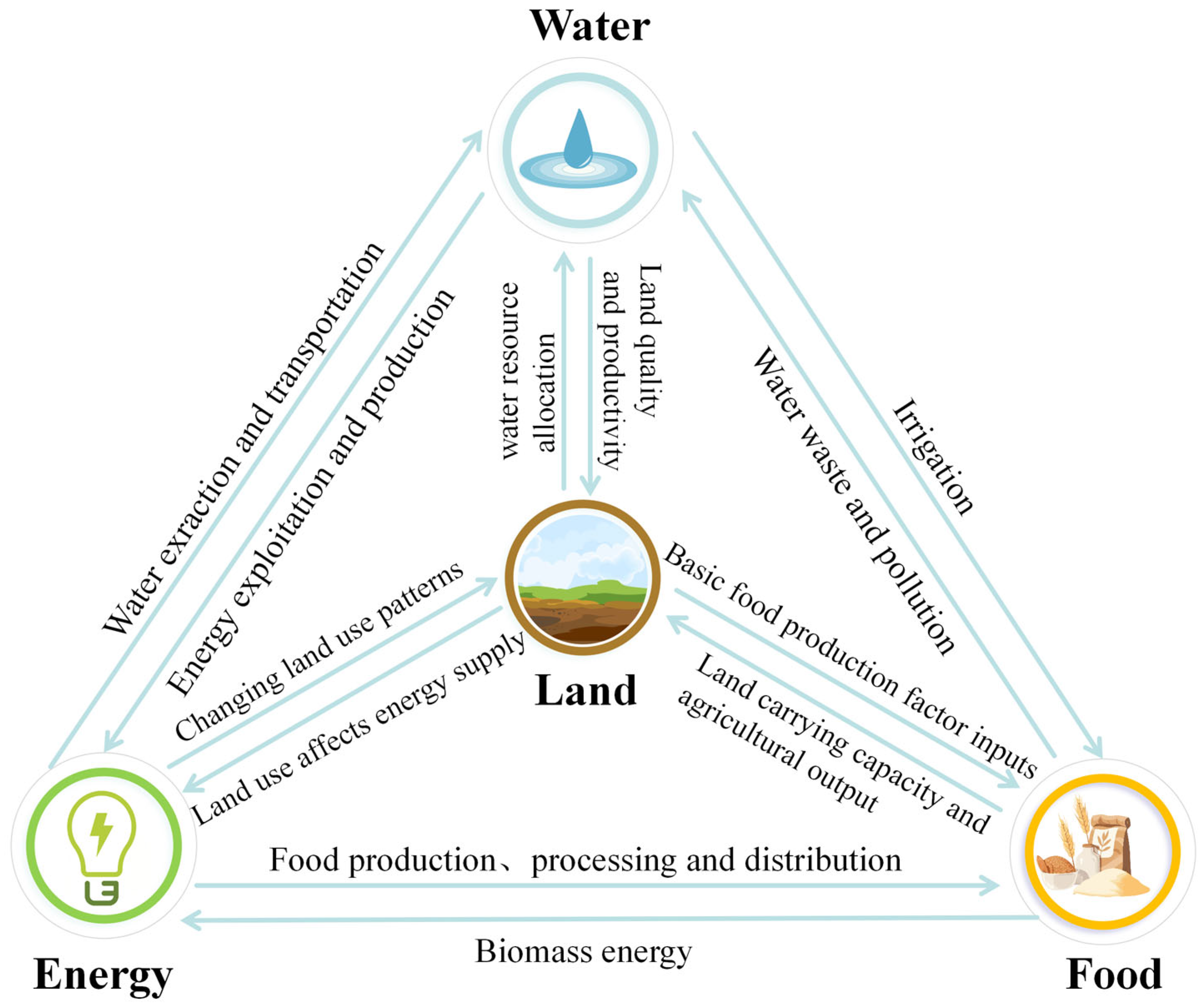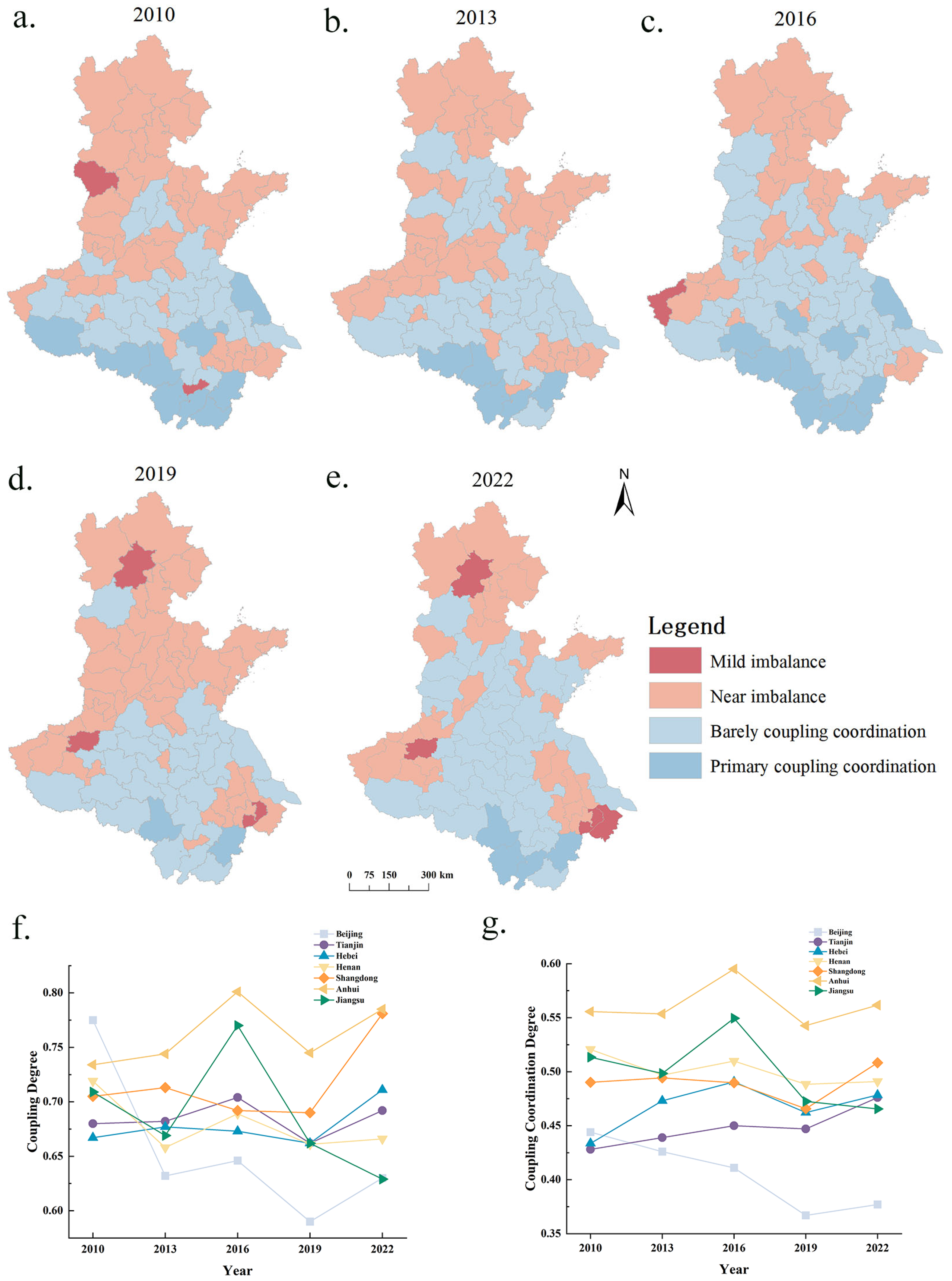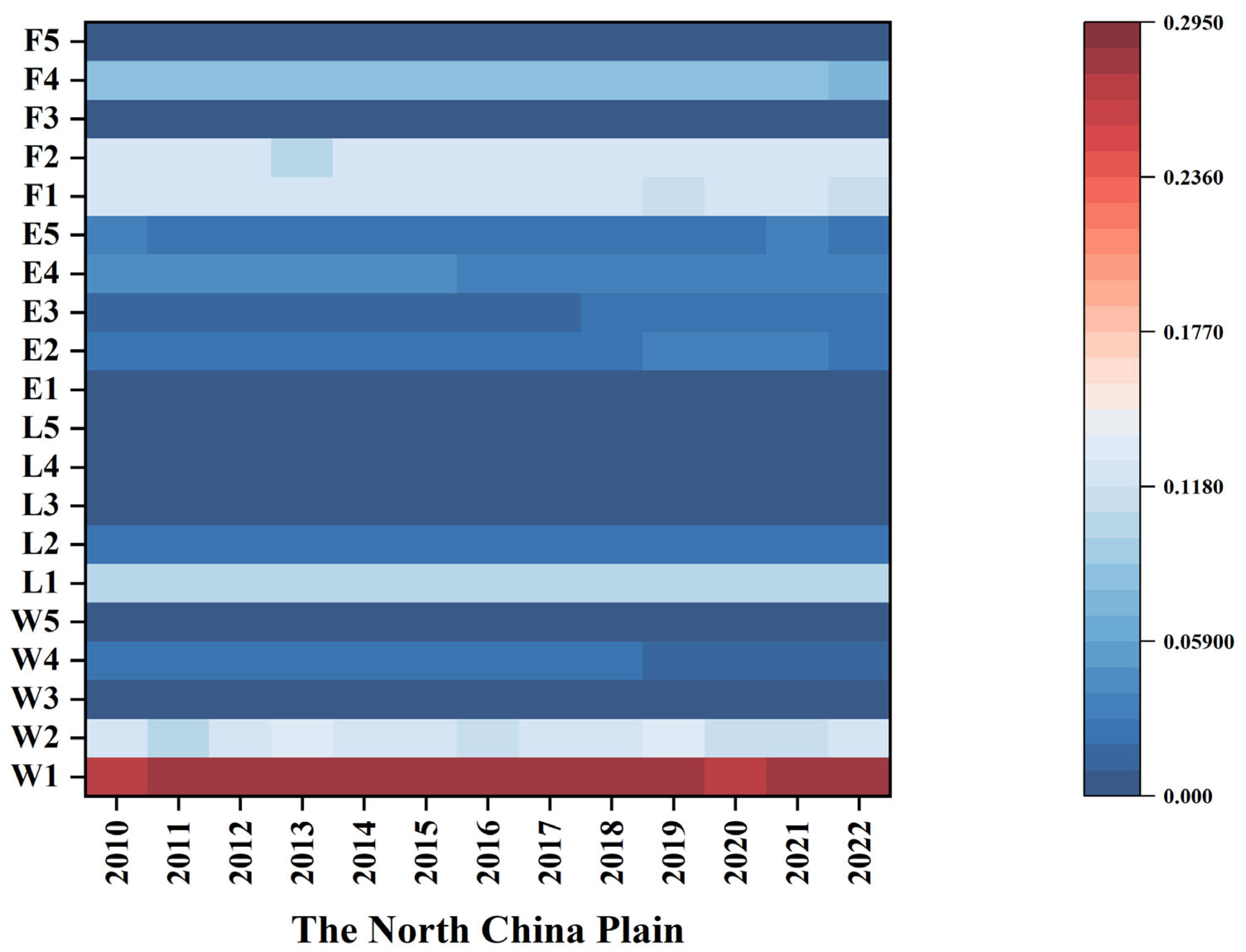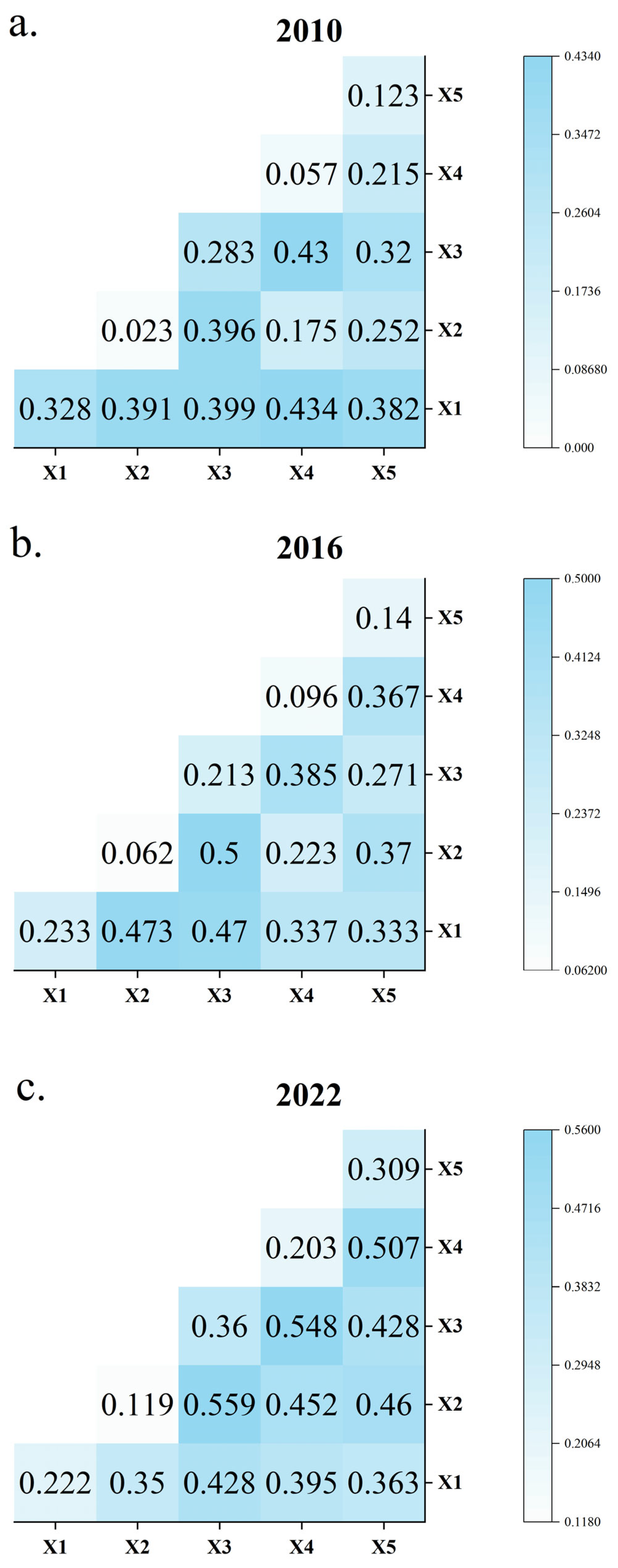Exploring the Coordinated Development of Water-Land-Energy-Food System in the North China Plain: Spatio-Temporal Evolution and Influential Determinants
Abstract
1. Introduction
2. Materials and Methods
2.1. Study Area
2.2. Data Sources
2.3. Methods
2.3.1. Development of the Indicator System
2.3.2. The Framework of the WLEF Indicator System
- (1)
- Normalization of Original Data
- (2)
- Following this, the entropy weight for indicator j is calculated using the steps described in Equations (3)–(6).
- (3)
- Following this, the overall evaluation index for each subsystem is computed through the multi-index weighted aggregation approach. The detailed mathematical expressions are provided below (Equations (7)–(10)):
- (4)
- Lastly, the integrated assessment index for the water-land-energy-food (WLEF) nexus is determined, as shown in Equation (11).
2.3.3. Coupling Coordination Model
2.3.4. Obstacle Degree Model
2.3.5. Geographic Detector
Factor Detection
Interaction Detection
3. Results
3.1. Spatial and Temporal Variation Characteristics of Coordinated Development of Water-Land-Energy-Food Nexus
3.1.1. Spatio-Temporal Evolution Analysis of the Integrated Development Level of the Water-Land-Energy-Food Nexus
3.1.2. Examination of the Spatiotemporal Development of the Coupling Coordination Degree Within the Water-Land-Energy-Food System
3.2. Key Drivers Affecting the Coupling Coordination Degree of the WLEF System
3.2.1. Examination of Internal Driving Mechanisms Behind the Coupled and Coordinated Development of Water, Land, Energy, and Food Resources
3.2.2. Assessment of External Influencing Factors on the Coordinated Development of the WLEF Coupling System
Identification and Examination of Influencing Elements
Examination of Interactions Between Influencing Factors
4. Discussion
4.1. Advantages of the Research
4.2. Research Findings and Rationality Analysis
4.3. Policy Implications
4.4. Limitations and Future Work
5. Conclusions
- (1)
- WLEF system coordination status: The overall WLEF coupling coordination degree fluctuated near the imbalance threshold (around 0.5), peaking in 2016 but declining overall after that. The water resources subsystem remained at a low level, while the energy subsystem showed notable growth. Southern cities in the North China Plain, especially Anhui province, demonstrated higher coordination levels than northern areas like Beijing. Some cities (e.g., Beijing, Zhengzhou, Wuxi, and Suzhou) entered mild imbalance by 2022, requiring targeted intervention.
- (2)
- Key Influencing Factors: Internally, severe water scarcity, indicated by per capita water availability as the primary obstacle, critically constrains coordination of the WLEF system. Other factors, such as grain sown area, water production capacity, and grain output, also play significant roles, underscoring the challenge of balancing high agricultural demands with limited water resources. Externally, primary industry’s added value, regional population, rural residents’ income, and urbanization rate increasingly influenced coupling coordination. Among factor interactions, after 2016, the interaction involving primary industry value significantly enhanced its explanatory power for the WLEF system’s coupling coordination—surpassing the individual effects of the two factors in the interaction (i.e., primary industry value and its paired factor). Additionally, the synergistic effect between primary industry value and urbanization rate further promoted system coordination.
- (3)
- Policy insights: Mitigating water scarcity is paramount, which requires regionally tailored strategies. In water-stressed areas, such as Beijing-Tianjin-Hebei, integrated land-use planning and the adoption of drought-tolerant, high-yield crops are needed to ease WLEF system pressures. For higher rainfall areas, including Anhui and Jiangsu, the emphasis should be on enhancing water infrastructure, optimizing the distribution of water resources, and encouraging diversified land-use practices. Concurrently, policies should support the industries with low water and energy consumption, advance agricultural modernization and intensive production, and foster the efficient, synergistic use of resources.
Supplementary Materials
Author Contributions
Funding
Data Availability Statement
Acknowledgments
Conflicts of Interest
Abbreviations
| NCP | North China Plain |
| WLEF | Water-Land-Energy-Food |
References
- Zuo, Q.; Wu, Q.; Yu, L.; Li, Y.; Fan, Y. Optimization of Uncertain Agricultural Management Considering the Framework of Water, Energy and Food. Agric. Water Manag. 2021, 253, 106907. [Google Scholar] [CrossRef]
- Li, J.; Cui, J.; Sui, P.; Yue, S.; Yang, J.; Lv, Z.; Wang, D.; Chen, X.; Sun, B.; Ran, M.; et al. Valuing the synergy in the water-energy-food nexus for cropping systems: A case in the North China Plain. Ecol. Indic. 2021, 127, 107741. [Google Scholar] [CrossRef]
- Cheng, Y.; Wang, J.; Shu, K. The Coupling and Coordination Assessment of Food-Water-Energy Systems in China Based on Sustainable Development Goals. Sustain. Prod. Consum. 2023, 35, 338–348. [Google Scholar] [CrossRef]
- AbdelHady, R.S.; Fahmy, H.S.; Pacini, N. Valuing of Wadi El-Rayan Ecosystem through Water–Food–Energy Nexus Approach. Ecohydrol. Hydrobiol. 2017, 17, 247–253. [Google Scholar] [CrossRef]
- Sharifi Moghadam, E.; Sadeghi, S.H.; Zarghami, M.; Delavar, M. Developing Sustainable Land-Use Patterns at Watershed Scale Using Nexus of Soil, Water, Energy, and Food. Sci. Total Environ. 2023, 856, 158935. [Google Scholar] [CrossRef] [PubMed]
- Wolde, Z.; Wei, W.; Likessa, D.; Omari, R.; Ketema, H. Understanding the Impact of Land Use and Land Cover Change on Water–Energy–Food Nexus in the Gidabo Watershed, East African Rift Valley. Nat. Resour. Res. 2021, 30, 2687–2702. [Google Scholar] [CrossRef]
- Rasul, G. Food, Water, and Energy Security in South Asia: A Nexus Perspective from the Hindu Kush Himalayan Region☆. Environ. Sci. Policy 2014, 39, 35–48. [Google Scholar] [CrossRef]
- Wang, Y.; Sun, R. Impact of land use change on coupling coordination degree of regional water-energy-food system: A case study of Beijing-Tianjin-Hebei Urban Agglomeration. J. Nat. Resour. 2022, 37, 582. [Google Scholar] [CrossRef]
- Ibarrola-Rivas, M.J.; Granados-Ramírez, R.; Nonhebel, S. Is the Available Cropland and Water Enough for Food Demand? A Global Perspective of the Land-Water-Food Nexus. Adv. Water Resour. 2017, 110, 476–483. [Google Scholar] [CrossRef]
- Qin, Q.; He, W.; Yuan, L.; Degefu, D.M.; Ramsey, T.S. Coupled and Coordinated Development of Water-Energy-Food-Ecology-Land System in the Yangtze River Delta, China. npj Clean Water 2025, 8, 38. [Google Scholar] [CrossRef]
- Shi, X.; Zhu, W. Spatio-Temporal Patterns and Drivers of Irrigation Water Requirement in Mainland China. Agric. Water Manag. 2025, 308, 109283. [Google Scholar] [CrossRef]
- Qin, J.; Duan, W.; Zou, S.; Chen, Y.; Huang, W.; Rosa, L. Global Energy Use and Carbon Emissions from Irrigated Agriculture. Nat. Commun. 2024, 15, 3084. [Google Scholar] [CrossRef]
- Li, M.; Cao, X.; Liu, D.; Fu, Q.; Li, T.; Shang, R. Sustainable Management of Agricultural Water and Land Resources Under Changing Climate and Socio-Economic Conditions: A Multi-Dimensional Optimization Approach. Agric. Water Manag. 2022, 259, 107235. [Google Scholar] [CrossRef]
- Chang, H.; Zhang, B.; Han, J.; Zhao, Y.; Cao, Y.; Yao, J.; Shi, L. Evaluation of the Coupling Coordination and Sustainable Development of Water–Energy–Land–Food System on a 40-Year Scale: A Case Study of Hebei, China. Land 2024, 13, 1089. [Google Scholar] [CrossRef]
- Bai, Y.; Wang, Y.; Xuan, X.; Weng, C.; Huang, X.; Deng, X. Tele-Connections, Driving Forces and Scenario Simulation of Agricultural Land, Water Use and Carbon Emissions in China’s Trade. Resour. Conserv. Recycl. 2024, 203, 107433. [Google Scholar] [CrossRef]
- Huang, F.; Yang, X.; Fang, Y.; Wang, S.; Kang, S. Exploring Water-and-Land-Adapted Spatial Layout of Crop Planting in North China. Chin. J. Eng. Sci. 2022, 24, 89. [Google Scholar] [CrossRef]
- Huang, Z.; Huo, Z.; Wang, W.; Zhu, J.; Zhang, C.; Xi, R. Analysis of Driving Factors for Land Subsidence in Typical Cities of the North China Plain Based on Geodetector Technology. J. Groundw. Sci. Eng. 2025, 13, 74–89. [Google Scholar] [CrossRef]
- Changming, L.; Jingjie, Y.; Kendy, E. Groundwater Exploitation and Its Impact on the Environment in the North China Plain. Water Int. 2001, 26, 265–272. [Google Scholar] [CrossRef]
- Xu, H.; Li, M.; Wang, T.; Ge, D.; Pan, Y. Decadal Water Management Measures Moderated the Subsidence of North China Plain. Sci. Bull. 2025, 70, 1538–1541. [Google Scholar] [CrossRef] [PubMed]
- Liu, Y.; Hu, X.; Zhang, Q.; Zheng, M. Improving Agricultural Water Use Efficiency: A Quantitative Study of Zhangye City Using the Static CGE Model with a CES Water−Land Resources Account. Sustainability 2017, 9, 308. [Google Scholar] [CrossRef]
- Liu, Y.; Wang, S.; Chen, B. Water–Land Nexus in Food Trade Based on Ecological Network Analysis. Ecol. Indic. 2019, 97, 466–475. [Google Scholar] [CrossRef]
- Chen, C.; Park, T.; Wang, X.; Piao, S.; Xu, B.; Chaturvedi, R.K.; Fuchs, R.; Brovkin, V.; Ciais, P.; Fensholt, R.; et al. China and India Lead in Greening of the World Through Land-Use Management. Nat. Sustain. 2019, 2, 122–129. [Google Scholar] [CrossRef]
- Shirzad, H.; Barati, A.A.; Ehteshammajd, S.; Goli, I.; Siamian, N.; Moghaddam, S.M.; Pour, M.; Tan, R.; Janečková, K.; Sklenička, P.; et al. Agricultural Land Tenure System in Iran: An Overview. Land Use Policy 2022, 123, 106375. [Google Scholar] [CrossRef]
- Yao, X.; Chen, W.; Song, C.; Gao, S. Sustainability and Efficiency of Water-Land-Energy-Food Nexus Based on Emergy-Ecological Footprint and Data Envelopment Analysis: Case of an Important Agriculture and Ecological Region in Northeast China. J. Clean. Prod. 2022, 379, 134854. [Google Scholar] [CrossRef]
- Zhuang, J.; Löffler, F.; Sayler, G. Closing Transdisciplinary Collaboration Gaps of Food-Energy-Water Nexus Research. Environ. Sci. Policy 2021, 126, 164–167. [Google Scholar] [CrossRef]
- Li, Y.; Zhang, L.; Zhang, P.; Li, X.; Hao, Y. Water-Energy-Food Nexus in China: An Interregional Comparison. Agric. Water Manag. 2024, 301, 108964. [Google Scholar] [CrossRef]
- Sobrosa Neto, R.D.C.; Berchin, I.I.; Magtoto, M.; Berchin, S.; Xavier, W.G.; Guerra, J.B.S.O.D.A. An Integrative Approach for the Water-Energy-Food Nexus in Beef Cattle Production: A Simulation of the Proposed Model to Brazil. J. Clean. Prod. 2018, 204, 1108–1123. [Google Scholar] [CrossRef]
- Afkhami, S.; Massah Bavani, A.R.; Gohari, A.; Naderi, M.M.; Saadi, T. Sustainability Analysis of Single vs. Multiple Adaptation Strategies in Tackling the Adverse Impacts of Climate Change on Groundwater Resources Using Water-Food-Energy Nexus Approach. J. Clean. Prod. 2024, 459, 142532. [Google Scholar] [CrossRef]
- Tian, G.; Li, J.; Wu, Z.; Zhao, Q.; Xia, Q.; Zhang, J.; Niu, X. Unveiling the Resilience of the Water-Energy-Food Nexus: A Context-Specific Framework and Evolutionary Insights for the Yellow River Basin. Agric. Water Manag. 2025, 315, 109514. [Google Scholar] [CrossRef]
- White, D.J.; Hubacek, K.; Feng, K.; Sun, L.; Meng, B. The Water-Energy-Food Nexus in East Asia: A Tele-Connected Value Chain Analysis Using Inter-Regional Input-Output Analysis. Appl. Energy 2018, 210, 550–567. [Google Scholar] [CrossRef]
- Liu, J.; Li, M.; Wu, M.; Luan, X.; Wang, W.; Yu, Z. Influences of the South–to-North Water Diversion Project and Virtual Water Flows on Regional Water Resources Considering Both Water Quantity and Quality. J. Clean. Prod. 2020, 244, 118920. [Google Scholar] [CrossRef]
- Yuan, W.; Wang, H.; Guo, W. Supply–Demand Synergy Assessment of the Water–Energy–Food Nexus in the Hanjiang River Basin Under Future Land Scenarios. Ecohydrology 2025, 18, e2762. [Google Scholar] [CrossRef]
- Qi, Y.; Farnoosh, A.; Lin, L.; Liu, H. Coupling Coordination Analysis of China’s Provincial Water-Energy-Food Nexus. Environ. Sci. Pollut. Res. 2022, 29, 23303–23313. [Google Scholar] [CrossRef]
- Bai, Y.; Xuan, X.; Wang, Y.; Weng, C.; Huang, X.; Deng, X. Revealing the Nexus Profile of Agricultural Water–Land–Food–GHG Flows in China. Resour. Conserv. Recycl. 2024, 204, 107528. [Google Scholar] [CrossRef]
- Chen, L.; Wang, X.; Lv, M.; Su, J.; Yang, B. Coupling Coordination and Spatial–Temporal Evolution of the Water–Land–Ecology System in the North China Plain. Agriculture 2024, 14, 1636. [Google Scholar] [CrossRef]
- Nie, Y.; Avraamidou, S.; Xiao, X.; Pistikopoulos, E.N.; Li, J.; Zeng, Y.; Song, F.; Yu, J.; Zhu, M. A Food-Energy-Water Nexus Approach for Land Use Optimization. Sci. Total Environ. 2019, 659, 7–19. [Google Scholar] [CrossRef]
- Wei, X.; Ye, Y.; Zhang, Q.; Li, B.; Wei, Z. Reconstruction of Cropland Change in North China Plain Area over the Past 300 Years. Glob. Planet. Chang. 2019, 176, 60–70. [Google Scholar] [CrossRef]
- Mo, X.; Liu, S.; Lin, Z.; Guo, R. Regional Crop Yield, Water Consumption and Water Use Efficiency and Their Responses to Climate Change in the North China Plain. Agric. Ecosyst. Environ. 2009, 134, 67–78. [Google Scholar] [CrossRef]
- Yin, J.; Yan, D.; Yang, Z.; Yuan, Z.; Yuan, Y.; Zhang, C. Projection of Extreme Precipitation in the Context of Climate Change in Huang-Huai-Hai Region, China. J. Earth Syst. Sci. 2016, 125, 417–429. [Google Scholar] [CrossRef]
- Zhu, L.; Bai, Y.; Zhang, L.; Si, W.; Wang, A.; Weng, C.; Shu, J. Water–Land–Food Nexus for Sustainable Agricultural Development in Main Grain-Producing Areas of North China Plain. Foods 2023, 12, 712. [Google Scholar] [CrossRef] [PubMed]
- Zhang, J.; Hu, L.; Sun, J.; Wang, D. Reconstructing Groundwater Storage Changes in the North China Plain Using a Numerical Model and GRACE Data. Remote Sens. 2023, 15, 3264. [Google Scholar] [CrossRef]
- Chen, X.; Thorp, K.R.; Ouyang, Z.; Hou, Y.; Zhou, B.; Li, Y. Energy Consumption Due to Groundwater Pumping for Irrigation in the North China Plain. Sci. Total Environ. 2019, 669, 1033–1042. [Google Scholar] [CrossRef]
- Jing, P.; Hu, T.; Sheng, J.; Mahmoud, A.; Liu, Y.; Yang, D.; Guo, L.; Li, M.; Wu, Y. Coupling Coordination and Spatiotemporal Dynamic Evolution of the Water-Energy-Food-Land (WEFL) Nexus in the Yangtze River Economic Belt, China. Environ. Sci. Pollut. Res. 2022, 30, 34978–34995. [Google Scholar] [CrossRef]
- Zhen, J.; Guo, Y.; Wang, Y.; Li, Y.; Shen, Y. Spatial-Temporal Evolution and Driving Factors of Water-Energy-Food-Ecology Coordinated Development in the Tarim River Basin. J. Hydrol. Reg. Stud. 2025, 58, 102288. [Google Scholar] [CrossRef]
- Chen, P. Effects of the Entropy Weight on TOPSIS. Expert Syst. Appl. 2021, 168, 114186. [Google Scholar] [CrossRef]
- Sun, J.; Yang, Y.; Qi, P.; Zhang, G.; Wu, Y. Development and Application of a New Water-Carbon-Economy Coupling Model (WCECM) for Optimal Allocation of Agricultural Water and Land Resources. Agric. Water Manag. 2024, 291, 108608. [Google Scholar] [CrossRef]
- Zou, S.; Liao, Z.; Liu, Y.; Fan, X. Research on the Impact of Heterogeneous Environmental Regulation on the Coordinated Development of China’s Water–Energy–Food System from a Spatial Perspective. Sustainability 2024, 16, 818. [Google Scholar] [CrossRef]
- Chen, A.; Hao, Z.; Wang, R.; Zhao, H.; Hao, J.; Xu, R.; Duan, H. Cultivated Land Sustainable Use Evaluation from the Perspective of the Water–Land–Energy–Food Nexus: A Case Study of the Major Grain-Producing Regions in Quzhou, China. Agronomy 2023, 13, 2362. [Google Scholar] [CrossRef]
- Xing, L.; Xue, M.; Hu, M. Dynamic Simulation and Assessment of the Coupling Coordination Degree of the Economy–Resource–Environment System: Case of Wuhan City in China. J. Environ. Manag. 2019, 230, 474–487. [Google Scholar] [CrossRef]
- Jiang, L.; Wu, Y.; He, X.; Fu, Q.; Wang, Z.; Jiang, Q. Dynamic Simulation and Coupling Coordination Evaluation of Water Footprint Sustainability System in Heilongjiang Province, China: A Combined System Dynamics and Coupled Coordination Degree Model. J. Clean. Prod. 2022, 380, 135044. [Google Scholar] [CrossRef]
- Cui, Y.; Zhang, J.; Xie, X.; Zhou, L.; Wu, W.; Yang, L. Evaluation of Comprehensive Benefits and the Degree of Coupling Coordination for Soil Health Products: A Case Study in Weifang City, China. Sci. Rep. 2025, 15, 11089. [Google Scholar] [CrossRef]
- Shi, T.; Yang, S.; Zhang, W.; Zhou, Q. Coupling Coordination Degree Measurement and Spatiotemporal Heterogeneity Between Economic Development and Ecological Environment—Empirical Evidence from Tropical and Subtropical Regions of China. J. Clean. Prod. 2020, 244, 118739. [Google Scholar] [CrossRef]
- Wang, D.; Shen, Y.; Zhao, Y.; He, W.; Liu, X.; Qian, X.; Lv, T. Integrated Assessment and Obstacle Factor Diagnosis of China’s Scientific Coal Production Capacity Based on the PSR Sustainability Framework. Resour. Policy 2020, 68, 101794. [Google Scholar] [CrossRef]
- Chen, J.; Wang, S.; Han, Y.; Zhang, Y.; Li, Y.; Zhang, B.; Li, X.; Zhang, J. Geodetector Analysis of Individual and Joint Impacts of Natural and Human Factors on Maternal and Child Health at the Provincial Scale. Sci. Rep. 2024, 14, 1643. [Google Scholar] [CrossRef]
- Bai, L.; Jiang, L.; Yang, D.; Liu, Y. Quantifying the Spatial Heterogeneity Influences of Natural and Socioeconomic Factors and Their Interactions on Air Pollution Using the Geographical Detector Method: A Case Study of the Yangtze River Economic Belt, China. J. Clean. Prod. 2019, 232, 692–704. [Google Scholar] [CrossRef]
- Lin, J.; Chen, W.; Qi, X.; Hou, H. Risk Assessment and Its Influencing Factors Analysis of Geological Hazards in Typical Mountain Environment. J. Clean. Prod. 2021, 309, 127077. [Google Scholar] [CrossRef]
- Li, W.; Liang, Y.; Liu, L.; He, Q.; Huang, J.; Yin, Z. Spatio-Temporal Impacts of Land Use Change on Water-Energy-Food Nexus Carbon Emissions in China, 2011–2020. Environ. Impact Assess. Rev. 2024, 105, 107436. [Google Scholar] [CrossRef]
- Elagib, N.A.; Al-Saidi, M. Balancing the Benefits from the Water–Energy–Land–Food Nexus through Agroforestry in the Sahel. Sci. Total Environ. 2020, 742, 140509. [Google Scholar] [CrossRef] [PubMed]
- Li, Q.; Yang, L.; Jiang, F.; Liu, Y.; Guo, C.; Han, S. Distribution Characteristics, Regional Differences and Spatial Convergence of the Water-Energy-Land-Food Nexus: A Case Study of China. Land 2022, 11, 1543. [Google Scholar] [CrossRef]
- Zhang, Y.; Wang, Y. Evaluation and Prediction of Water-Energy-Food Nexus Under Land Use Changes in the Yellow River Basin, China. Sustain. Futures 2024, 8, 100307. [Google Scholar] [CrossRef]
- Yuan, Y.; Wei, S.; Wan, D.; Liu, D. A Study of Land-Economy-Society-Ecology Coordination in the Yangtze River Delta Based on Coupled Coordination Degree Model. Int. Rev. Econ. Financ. 2024, 95, 103474. [Google Scholar] [CrossRef]
- Gu, W.; Ma, G.; Wang, R.; Scherer, L.; He, P.; Xia, L.; Zhu, Y.; Bi, J.; Liu, B. Climate Adaptation Through Crop Migration Requires a Nexus Perspective for Environmental Sustainability in the North China Plain. Nat. Food 2024, 5, 569–580. [Google Scholar] [CrossRef] [PubMed]
- Psomas, A.; Vryzidis, I.; Spyridakos, A.; Mimikou, M. MCDA Approach for Agricultural Water Management in the Context of Water–Energy–Land–Food Nexus. Oper. Res. Int. J. 2021, 21, 689–723. [Google Scholar] [CrossRef]
- Mazurek, J.; Strzałka, D. On the Monte Carlo Weights in Multiple Criteria Decision Analysis. PLoS ONE 2022, 17, e0268950. [Google Scholar] [CrossRef]
- Wang, S.; Yang, R.; Shi, S.; Wang, A.; Liu, T.; Yang, J. Characteristics and Influencing Factors of the Spatial and Temporal Variability of the Coupled Water–Energy–Food Nexus in the Yellow River Basin in Henan Province. Sustainability 2023, 15, 13977. [Google Scholar] [CrossRef]







| System | Indicators | Units | Nature | Weight |
|---|---|---|---|---|
| Water subsystem | Per capita water resources (W1) | Total water resources/Total population (m3/cap) | + | 0.60 |
| Modulus of water production (W2) | Total water resources/Total area (10,000 m3/km2) | + | 0.29 | |
| Proportion of industrial water consumption (W3) | Industrial water use/Total water use (%) | − | 0.01 | |
| Proportion of agricultural water consumption (W4) | Agricultural water use/Total water use (%) | − | 0.08 | |
| Per capita water consumption (W5) | Total water use/Total population (m3/cap) | − | 0.02 | |
| Land subsystem | Per capita construction land area (L1) | Total population/Total construction area (ha/cap) | + | 0.69 |
| Per capita cultivated land area of rural households (L2) | Cultivated land/Rural population (ha/cap) | + | 0.18 | |
| Density of population (L3) | Total population/Total area (cap/ha) | − | 0.08 | |
| Green coverage rate of built-up area (L4) | Statistical data (%) | + | 0.04 | |
| Discharge of industrial wastewater per area (L5) | Total industrial wastewater discharge/Total area (10,000 tons/km2) | − | 0.01 | |
| Energy subsystem | Industrial SO2 emissions (E1) | Statistical data (10,000 t) | − | 0.06 |
| Per capita Energy consumption (E2) | Total energy consumption/Total population (tons of SC/cap) | − | 0.21 | |
| Total electricity use (E3) | Statistical data (10,000 KW) | − | 0.15 | |
| Total power of agricultural machinery (E4) | Statistical data (10,000 KW) | − | 0.34 | |
| Ratio of industrial solid wastes treated and utilized (E5) | Statistical data (%) | + | 0.25 | |
| Food subsystem | Output of grain (F1) | Statistical data (10,000 t) | + | 0.34 |
| Grain sown area (F2) | Statistical data (1000 ha) | + | 0.33 | |
| Intensity of pesticide and fertilizer application (F3) | Application amount of agricultural pesticide and fertilizer/sowing area of main crops (t/ha) | − | 0.02 | |
| Effective irrigated area (F4) | Statistical data (1000 ha) | + | 0.27 | |
| Engel coefficient (F5) | Statistical data (%) | − | 0.05 |
| Impact Factor | Indicators Name | Description of Indicators |
|---|---|---|
| X1 | GDP per capita | As a key measure of economic development, per capita GDP impacts the WLEF system by shaping patterns of capital distribution and the level of technological investment. |
| X2 | Value Added of the Primary Industry | As a crucial indicator reflecting the economic contribution of agricultural production, the value-added of the primary industry generates both positive driving effects and potential pressures on the WLEF system. |
| X3 | Urbanization level | Urbanization drives the evolution of the WLEF system by fostering population concentration and increasing land use competition. |
| X4 | Total regional population | Population size reflects regional demand and impacts the WLEF system’s overall carrying capacity. |
| X5 | Rural disposable income per capita | Fluctuations in income influence farmers’ decision-making processes, thereby affecting the agricultural production system. The role of rural households in shaping the WLEF system should be examined from an individual-level perspective. |
| Impact Factor | 2010 | 2016 | 2022 | |||
|---|---|---|---|---|---|---|
| q-value | rank | q-value | rank | q-value | rank | |
| X1 | 0.328 | 1 | 0.233 | 1 | 0.222 | 2 |
| X2 | 0.023 | 4 | 0.062 | 3 | 0.119 | 3 |
| X3 | 0.283 | 2 | 0.213 | 1 | 0.360 | 1 |
| X4 | 0.057 | 4 | 0.096 | 3 | 0.203 | 2 |
| X5 | 0.123 | 3 | 0.140 | 2 | 0.309 | 1 |
Disclaimer/Publisher’s Note: The statements, opinions and data contained in all publications are solely those of the individual author(s) and contributor(s) and not of MDPI and/or the editor(s). MDPI and/or the editor(s) disclaim responsibility for any injury to people or property resulting from any ideas, methods, instructions or products referred to in the content. |
© 2025 by the authors. Licensee MDPI, Basel, Switzerland. This article is an open access article distributed under the terms and conditions of the Creative Commons Attribution (CC BY) license (https://creativecommons.org/licenses/by/4.0/).
Share and Cite
Dai, Z.; Wang, J.; Fu, W.; Yang, J.; Xia, X. Exploring the Coordinated Development of Water-Land-Energy-Food System in the North China Plain: Spatio-Temporal Evolution and Influential Determinants. Land 2025, 14, 1782. https://doi.org/10.3390/land14091782
Dai Z, Wang J, Fu W, Yang J, Xia X. Exploring the Coordinated Development of Water-Land-Energy-Food System in the North China Plain: Spatio-Temporal Evolution and Influential Determinants. Land. 2025; 14(9):1782. https://doi.org/10.3390/land14091782
Chicago/Turabian StyleDai, Zihong, Jie Wang, Wei Fu, Juanru Yang, and Xiaoxi Xia. 2025. "Exploring the Coordinated Development of Water-Land-Energy-Food System in the North China Plain: Spatio-Temporal Evolution and Influential Determinants" Land 14, no. 9: 1782. https://doi.org/10.3390/land14091782
APA StyleDai, Z., Wang, J., Fu, W., Yang, J., & Xia, X. (2025). Exploring the Coordinated Development of Water-Land-Energy-Food System in the North China Plain: Spatio-Temporal Evolution and Influential Determinants. Land, 14(9), 1782. https://doi.org/10.3390/land14091782






